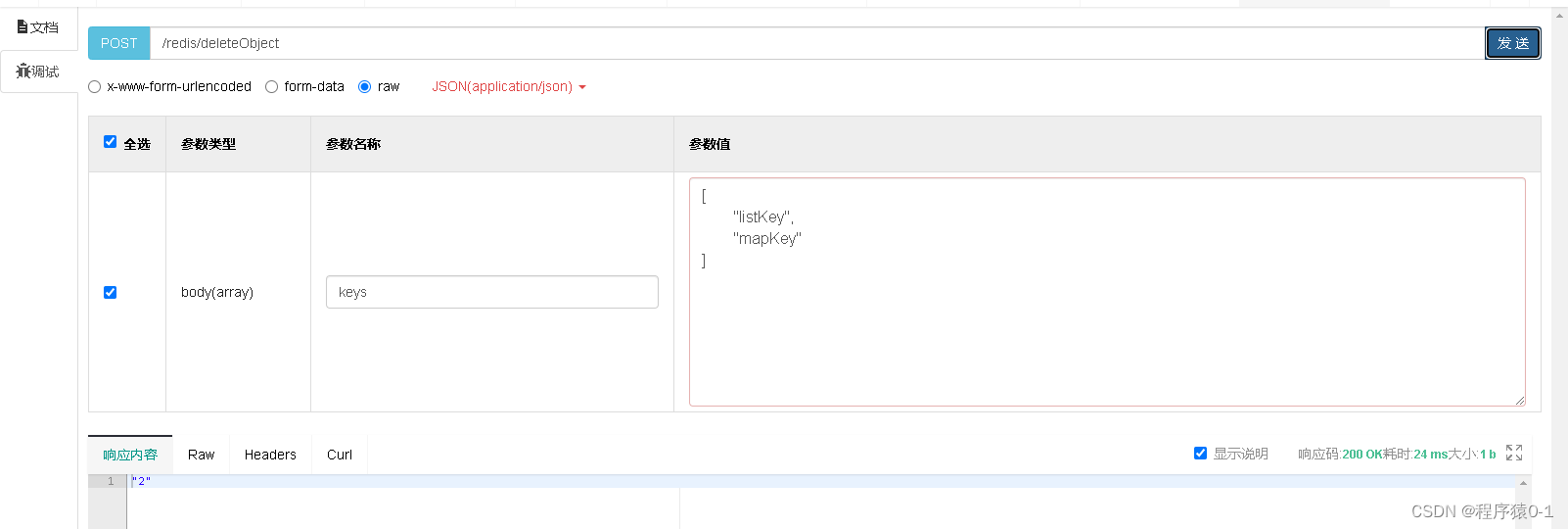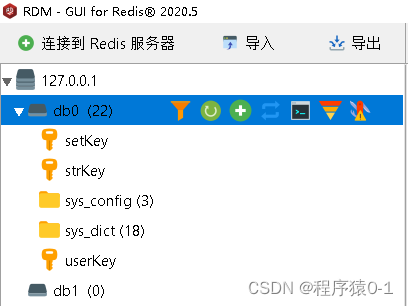Article directory
foreword
This article implements the integration of Redis in SpringBoot, uses the RedisTemplate object to operate and writes tool classes for some common methods.
1. Introducing dependencies
<!-- redis 缓存操作 -->
<dependency>
<groupId>org.springframework.boot</groupId>
<artifactId>spring-boot-starter-data-redis</artifactId>
</dependency>
<!-- pool 对象池 -->
<!-- 使用lettuce客户端需要引入commons-pool2依赖 -->
<dependency>
<groupId>org.apache.commons</groupId>
<artifactId>commons-pool2</artifactId>
</dependency>
2. Basic configuration
1. Configure the application.yml file
The configuration is as follows:
spring:
# redis 配置
redis:
# 地址
host: 127.0.0.1
# 端口,默认为6379
port: 6379
# 密码,没有不填
password: ''
# 连接超时时间
timeout: 10s
lettuce:
pool:
# 连接池中的最小空闲连接
min-idle: 0
# 连接池中的最大空闲连接
max-idle: 8
# 连接池的最大数据库连接数
max-active: 8
# #连接池最大阻塞等待时间(使用负值表示没有限制)
max-wait: -1ms
2. RedisTemplate configuration
code show as below:
/*
*自定义Redis配置类,进行序列化以及RedisTemplate设置
*/
@Configuration
@EnableCaching
public class RedisConfig extends CachingConfigurerSupport {
@Bean
public RedisTemplate<Object, Object> redisTemplate(RedisConnectionFactory connectionFactory){
RedisTemplate<Object, Object> template = new RedisTemplate<>();
template.setConnectionFactory(connectionFactory);
FastJson2JsonRedisSerializer serializer = new FastJson2JsonRedisSerializer(Object.class);
ObjectMapper mapper = new ObjectMapper();
mapper.setVisibility(PropertyAccessor.ALL, JsonAutoDetect.Visibility.ANY);
mapper.enableDefaultTyping(ObjectMapper.DefaultTyping.NON_FINAL);
serializer.setObjectMapper(mapper);
template.setValueSerializer(serializer);
// 使用StringRedisSerializer序列化和反序列化redis的key值
template.setKeySerializer(new StringRedisSerializer());
// 使用StringRedisSerializer序列化和反序列化redis hash类型的key值
template.setHashKeySerializer(new StringRedisSerializer());
// 序列化和反序列化redis hash类型的value值
template.setHashValueSerializer(serializer);
template.afterPropertiesSet();
return template;
}
}
3. Jackson2JsonRedisSerializer serialization strategy configuration
/**
* Jackson2JsonRedisSerializer序列化策略
*/
public class FastJson2JsonRedisSerializer<T> implements RedisSerializer<T> {
private ObjectMapper objectMapper = new ObjectMapper();
public static final Charset DEFAULT_CHARSET = Charset.forName("UTF-8");
private Class<T> clazz;
static
{
ParserConfig.getGlobalInstance().setAutoTypeSupport(true);
}
public FastJson2JsonRedisSerializer(Class<T> clazz)
{
super();
this.clazz = clazz;
}
@Override
public byte[] serialize(T t) throws SerializationException
{
if (t == null)
{
return new byte[0];
}
return JSON.toJSONString(t, SerializerFeature.WriteClassName).getBytes(DEFAULT_CHARSET);
}
@Override
public T deserialize(byte[] bytes) throws SerializationException
{
if (bytes == null || bytes.length <= 0)
{
return null;
}
String str = new String(bytes, DEFAULT_CHARSET);
return JSON.parseObject(str, clazz);
}
public void setObjectMapper(ObjectMapper objectMapper)
{
Assert.notNull(objectMapper, "'objectMapper' must not be null");
this.objectMapper = objectMapper;
}
protected JavaType getJavaType(Class<?> clazz)
{
return TypeFactory.defaultInstance().constructType(clazz);
}
}
3. Tools
一些常用方法的封装
code show as below:
/**
* redis缓存工具类
*/
@Component
public class RedisCache {
@Autowired
private RedisTemplate redisTemplate;
/**
* 缓存基本的对象,Integer、String、实体类等
*
* @param key 缓存的键值
* @param value 缓存的值
*/
public <T> void setCacheObject(final String key, final T value)
{
redisTemplate.opsForValue().set(key, value);
}
/**
* 缓存基本的对象,Integer、String、实体类等
*
* @param key 缓存的键值
* @param value 缓存的值
* @param timeout 时间
* @param timeUnit 时间颗粒度
*/
public <T> void setCacheObject(final String key, final T value, final Integer timeout, final TimeUnit timeUnit)
{
redisTemplate.opsForValue().set(key, value, timeout, timeUnit);
}
/**
* 设置有效时间
* 默认【秒】为单位
* @param key Redis键
* @param timeout 超时时间
* @return true=设置成功;false=设置失败
*/
public boolean expire(final String key, final long timeout)
{
return expire(key, timeout, TimeUnit.SECONDS);
}
/**
* 设置有效时间
* 【自定义时间单位】
* @param key Redis键
* @param timeout 超时时间
* @param unit 时间单位
* @return true=设置成功;false=设置失败
*
*
* 《TimeUnit详解》
* TimeUnit.DAYS //天
* TimeUnit.HOURS //小时
* TimeUnit.MINUTES //分钟
* TimeUnit.SECONDS //秒
* TimeUnit.MILLISECONDS //毫秒
* TimeUnit.NANOSECONDS //毫微秒
* TimeUnit.MICROSECONDS //微秒
*/
public boolean expire(final String key, final long timeout, final TimeUnit unit)
{
return redisTemplate.expire(key, timeout, unit);
}
/**
* 获得缓存的基本对象。
*
* @param key 缓存键值
* @return 缓存键值对应的数据
*/
public <T> T getCacheObject(final String key)
{
ValueOperations<String, T> operation = redisTemplate.opsForValue();
return operation.get(key);
}
/**
* 删除单个key
*
* @param key
*/
public boolean deleteKey(final String key)
{
return redisTemplate.delete(key);
}
/**
* 删除多个key
*
* @param collection 多个对象
* @return
*/
public long deleteKeys(final Collection collection)
{
return redisTemplate.delete(collection);
}
/**
* 缓存List数据
*
* @param key 缓存的键值
* @param dataList 待缓存的List数据
* @return 缓存的对象
*/
public <T> long setCacheList(final String key, final List<T> dataList)
{
Long count = redisTemplate.opsForList().rightPushAll(key, dataList);
return count == null ? 0 : count;
}
/**
* 获得缓存的list对象
*
* @param key 缓存的键值
* @return 缓存键值对应的数据
*/
public <T> List<T> getCacheList(final String key)
{
return redisTemplate.opsForList().range(key, 0, -1);
}
/**
* 缓存Set
*
* @param key 缓存键值
* @param value 缓存的数据可以传多个,用,隔开
* 例如:setCacheSet("key","1","2","3")
* @return 缓存数据的对象
*/
public <T> long setCacheSet(final String key, final Object... value)
{
Long count = redisTemplate.opsForSet().add(key, value);
return count == null ? 0 : count;
}
/**
* 获得缓存的set
*
* @param key
* @return
*/
public <T> Set<T> getCacheSet(final String key)
{
return redisTemplate.opsForSet().members(key);
}
/**
* 缓存Map
*
* @param key
* @param dataMap
*/
public <T> void setCacheMap(final String key, final Map<String, T> dataMap)
{
if (dataMap != null) {
redisTemplate.opsForHash().putAll(key, dataMap);
}
}
/**
* 获得缓存的Map
*
* @param key
* @return
*/
public <T> Map<String, T> getCacheMap(final String key)
{
return redisTemplate.opsForHash().entries(key);
}
/**
* 获取缓存map的所有key值
*
* @param key
* @return
*/
public <T> Set<String> getCacheMapKeys(final String key)
{
return redisTemplate.opsForHash().keys(key);
}
/**
* 往Hash中存入数据
*
* @param key Redis键
* @param hKey Hash键
* @param value 值
*/
public <T> void setCacheMapValue(final String key, final String hKey, final T value)
{
redisTemplate.opsForHash().put(key, hKey, value);
}
/**
* 获取Hash中的数据
*
* @param key Redis键
* @param hKey Hash键
* @return Hash中的对象
*/
public <T> T getCacheMapValue(final String key, final String hKey)
{
HashOperations<String, String, T> opsForHash = redisTemplate.opsForHash();
return opsForHash.get(key, hKey);
}
/**
* 获取多个Hash中的数据
*
* @param key Redis键
* @param hKeys Hash键集合
* @return Hash对象集合
*/
public <T> List<T> getMultiCacheMapValue(final String key, final Collection<Object> hKeys)
{
return redisTemplate.opsForHash().multiGet(key, hKeys);
}
/**
* 模糊查询所有key值
*
* @param pattern 字符串前缀
* @return 对象列表
*/
public Collection<String> keys(final String pattern)
{
return redisTemplate.keys(pattern);
}
}
4. Method example
basic object type
1. Cache basic object types
- method example
//注入自定义封装的工具类
@Autowired
private RedisCache redisCache;
/**
* 缓存基本对象类型 String、Integer、实体类等.....
* @return
*/
@PostMapping("/setCacheObject")
@ApiOperation(value ="缓存基本对象")
public String setCacheObject(){
//自定义key
String key = "strKey";
//自定义value
String value = "张三";
//缓存基本对象
redisCache.setCacheObject(key,value);
return "SUCCESS!";
}
- example result

2. Cache basic objects and set expiration time
- method example
/**
* 设置过期时间
* 缓存基本对象类型 String、Integer、实体类等.....
* @return
*/
@PostMapping("/setCacheObjectByTime")
@ApiOperation(value ="缓存基本对象并设置过期时间")
public String setCacheObjectByTime(){
//自定义key
String key = "strTimeKey";
//自定义value
String value = "过期时间value";
//过期时间
Integer timeOut = 10;
//放入缓存,并设置过期时间,单位为秒
redisCache.setCacheObject(key,value,timeOut, TimeUnit.SECONDS);
return "SUCCESS!";
}
- example result

3. Cache entity class
- method example
/**
* 缓存实体类对象
* @return
*/
@PostMapping("/setCacheObjectByEntity")
@ApiOperation(value ="缓存实体类对象")
public String setCacheObjectByEntity(){
//自定义key
String key = "userKey";
TUser tUser = new TUser();
tUser.setName("张三");
tUser.setAge("18");
//放入缓存
redisCache.setCacheObject(key,tUser);
return "SUCCESS!";
}
- example result

4. Get the cache object
已实体类对象为例
- method example
/**
* 获取缓存实体对象 entity
* @param key:缓存的key值
* @return TUser
*/
@GetMapping("/getCacheObjectByEntity")
@ApiOperation(value ="获取缓存基本对象 - 实体类")
public TUser getCacheObjectByEntity(String key){
//在缓存中获取key值
TUser tUser = redisCache.getCacheObject(key);
System.out.println(tUser);
return tUser;
}
- example result

List type
1. Cache List type data
- code example
/**
*缓存 List 类型
* @return
*/
@PostMapping("/setCacheList")
@ApiOperation(value ="缓存List类型")
public String setCacheList(){
//自定义key值
String key = "listKey";
//自定义List数据
List<String> list = new ArrayList<>();
list.add("张三");
list.add("李四");
//放入缓存
redisCache.setCacheList(key,list);
//设置key过期时间,10秒钟过期
// redisCache.expire(key,10,TimeUnit.SECONDS);
return "SUCCESS!";
}
- example result

2. Get the cached Lsit object
- code example
/**
* 获取缓存Lsit对象
* @param key:缓存的key值
* @return TUser
*/
@GetMapping("/getCacheList")
@ApiOperation(value ="获取缓存Lsit对象")
public List<String> getCacheList(String key){
//在缓存中获取key对应的值
List<String> cacheList = redisCache.getCacheList(key);
System.out.println(cacheList);
return cacheList;
}
- example result

Set type
1. Cache Set type data
- code example
/**
* 缓存 Set 类型
* @return
*/
@PostMapping("/setCacheSet")
@ApiOperation(value ="缓存Set类型")
public String setCacheSet(){
//自定义key值
String key = "setKey";
//自定义List数据
TUser u1 = new TUser("张三","18");
TUser u2 = new TUser("张三","18");
TUser u3 = new TUser("李四","18");
//放入缓存
redisCache.setCacheSet(key,u1,u2,u3);
//设置key过期时间,10秒钟过期
// redisCache.expire(key,10,TimeUnit.SECONDS);
return "SUCCESS!";
}
- example result

2. Get the cached Set object
- code example
/**
* 获取缓存Set对象
* @param key:缓存的key值
* @return Set<TUser>
*/
@GetMapping("/getCacheSet")
@ApiOperation(value ="获取缓存Set对象")
public Set<TUser> getCacheSet(String key){
//在缓存中获取key对应的值
Set<TUser> cacheSet = redisCache.getCacheSet(key);
System.out.println(cacheSet);
return cacheSet;
}
- example result

Map type
1. Cache Map type
- code example
/**
* 缓存 Map 类型
* @return
*/
@PostMapping("/setCacheHash")
@ApiOperation(value ="缓存Map类型")
public String setCacheMap(){
//自定义key值
String key = "mapKey";
//自定义List数据
Map<String,Object> map = new HashMap<>();
map.put("name","张三");
map.put("age",18);
map.put("sex","男");
//放入缓存
redisCache.setCacheMap(key,map);
return "SUCCESS!";
}
- example result

2. Get the cached Map object
- code example
/**
*获取缓存Map对象
* @param key:缓存的key值
*/
@GetMapping("/getCacheHash")
@ApiOperation(value ="获取缓存Map对象")
public Map<String, Object> getCacheHash(String key){
//在缓存中获取key对应的值
Map<String, Object> cacheMap = redisCache.getCacheMap(key);
System.out.println(cacheMap);
return cacheMap;
}
- example result

3. Get all key values in the Map
- code example
/**
* 获取缓存map的所有key值
* @return
*/
@GetMapping("/getCacheMapKeys")
@ApiOperation(value ="获取缓存map的所有key值")
public Set<String> getCacheMapKeys(String key){
//添加hash数据
Set<String> mapKey = redisCache.getCacheMapKeys(key);
System.out.println(mapKey);
return mapKey;
}
- example result

4. Get the value of the specified key of the cache map
- code example
/**
*获取缓存map的指定key的value
* @param key:redis的key值
* @return
*/
@GetMapping("/getMultiCacheMapValue")
@ApiOperation(value ="获取缓存map的指定key的value")
public List<Object> getMultiCacheMapValue(String key){
//获取map中key为name和sex 的 value
Set<Object> hkeys = new HashSet<>();
hkeys.add("name");
hkeys.add("sex");
//添加hash数据
List<Object> mapValue = redisCache.getMultiCacheMapValue(key, hkeys);
System.out.println(mapValue);
return mapValue;
}
- example result

Cache Key value operation
1. Fuzzy query caches all keys
- code example
/**
* 模糊查询所有key值
* 传参例如:
* 查询所有已Key结尾的key值 *Key
* 查询所有已Key开头的key值 Key*
* @return
*/
@GetMapping("/likeKeys")
@ApiOperation(value ="模糊查询所有key值")
public Set<String> likeKeys(String keyName){
//添加hash数据
Set<String> keys = redisCache.keys(keyName);
System.out.println(keys);
return keys;
}
- Result example
All cached key values ending with Key Parameters: *Key

All cached key values starting with map

2. Delete single/multiple keys
- code example
/**
* 删除单个/多个key
* @return
*/
@PostMapping("/deleteObject")
@ApiOperation(value ="删除单个/多个key")
public String deleteObject(@RequestBody List<String> keys){
//添加hash数据
long size = redisCache.deleteKeys(keys);
return size+"";
}
- Result example

It can be seen that listKey and mapKey have been deleted

3. Set the expiration time of the cache key
- code example
/**
* 设置缓存key的过期时间
* @return
*/
@GetMapping("/setKeyTimout")
@ApiOperation(value ="模糊查询所有key值")
public String setKeyTimout(String key,Integer timeOut){
/**
* key:缓存key值
* timeOut:过期时间
* TimeUnit.SECONDS:时间单位(秒)
*/
redisCache.expire(key,timeOut,TimeUnit.SECONDS);
return "SUCCESS";
}
-
Example result
request

Effect

Summarize
The above is the case of integrating Redis in SpringBoot and operating the cache through RedisTemplate.